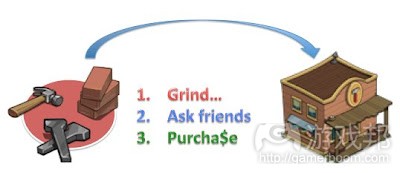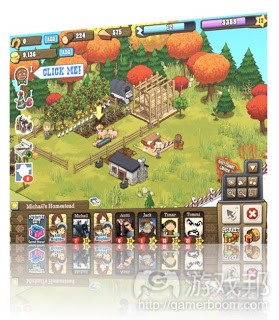将游戏玩家转变为付费用户的4个步骤
在免费游戏经济中,我们有许多方法可以从玩家身上盈利,但它们的基本设想和理念仍然一样。以下是我设计盈利模式时牢记在心的4个步骤,因为所有的步骤都会与游戏核心循环相绑定,并由此增加留存率和病毒性。
步骤1:玩乐&学习
并非所有玩家都是天才游戏达人,所以我们设置一些人人皆宜的简单机制,然后根据他们所投入的时间给予奖励。
这听起来很简单,但通常情况下对于想让玩家靠自己的能力赢得胜利的游戏设计师而言,这却是非常之难的任务,因为其现实目标是让98%的玩家感觉自己战胜了游戏。
例如在《Treasure Isle》这款游戏中,玩家要探索一系列小岛并挖掘宝藏,每个小岛都分割成一个个格子,玩家要点击其中的格子。并由游戏引擎来决定玩家是否找到了宝藏、钱币、水果或根本没有找到东西——几乎每次挖掘都会有所收获,但只有一小部分含有宝藏。
值得一提的是,这种游戏玩法基本上没有什么技术含量。没有困难的选择,只要点击和挖掘!通过这种简单的重复操作,玩家可以赢取经验值,升级,寻宝并依照Zynga的设定庆祝自己每一次小小的成就。
步骤2:病毒式扩散
如果玩家是为了与好友一试高下而花钱,我们就需要确保他们的好友也在游戏中。但如果这是款糟糕的游戏,你就难以说服玩家怂恿自己的好友也参与其中(游戏邦注:但好游戏也并不能确保玩家就会向好友推荐游戏)。
为了保证游戏获得病毒传播,你得为设计游戏的传播需求。玩家在游戏中为什么需要好友?这正是你设计病毒功能时需要考虑的问题。
案例:
上图是病毒传播最普遍的模式。玩家开始建设一橦房时,若要完成施工,就需要一些特殊的材料。但此时玩家知道要获得这些道具,他得再玩好几回游戏,重复做许多任务才能实现目标。玩家可以通过寻求好友帮助
来跳过这种刷任务的过程。第三个选择就是跳过刷任务和等待好友帮助,直接付费购得道具。
步骤3:合作&竞争
这个步骤其实与上一步联系紧密,因为如果没有合作与竞争对象,游戏也就不存在合作与竞争的概念了。
最重要的是要记住 ,合作应该发生于玩家可以轻易炫耀自身成就的游戏区域。双方玩家都应该从这种合作中获益。
例如,《FrontierVille》鼓励玩家帮自己好友的宅地清除草木,并为双方提供钱币和经验值等奖励。注意,这里的奖励与玩家清除草木所投入的时间并不成比例,因为Zynga鼓励玩家多访问好友的宅地。
帮助好友的动机越强,玩家访问好友的频率就会越高,而访问越频繁,他们就越可能与好友比较自己的游戏进程。
步骤4:花钱节省成本
当玩家经常与好友比较自己的游戏进程时,其花钱的的动机也会愈加强烈。
可以通过平衡游戏经济系统,即让玩家刚开始时进展迅速,之后又开始减缓来刺激玩家消费。当进展减缓时,你就为玩家提供各种加速的方法,令其实现下一个目标。
游戏邦注:原文发表于2012年5月4日,所涉事件及数据以当时为准。(本文为游戏邦/gamerboom.com编译,拒绝任何不保留版权的转载,如需转载请联系:游戏邦)
From Players to Payers 4 steps to conversion
There are tons of way to monetize players in freemium game economies but certain base assumption and ideas still remain the same. Here are 4 steps that I keep in mind when designing monetization as all of the step are tied to the game’s core loop and thus increase also retention and virality.
Step 1: Enjoy & Learn
Not all players are talented gamers, so we have to have mechanics that’s so simple anyone can do it, and then reward them handsomely inline with the time they spend.
Sounds pretty simple but usually this is surprisingly hard for game designers who want to make players earn they way to success, when the goal in fact is to make 98% of your players feel like they’re killing it in your game.
For example in Treasure Isle players explore series of islands and dig for treasure. Each island is split into a grid, players click to dig one of the grid cells. The game engine decides if the player
found treasure, coins, fruit, or nothing at all – nearly every dig has some reward, few have treasure.
The beauty is that there is no skill to the game. No hard choices. Just click and dig! Through this simple repeatable action, players earn experience, level up, find treasure and along the way Zynga make sure they get to celebrate every little success.
Step 2: Go Viral!
If our players are going to spend money because they want to keep up with their friends playing the game, we need to make sure they’ve got someone to keep up with. Yet, if its a bad game there’s nothing that you can do to convince players to tell their friends about it (unless it’s so bad it’s actually good), but just because its a good game doesn’t mean they’ll tell their friends either.
To ensure that the game goes viral you have to design demand for virality. Why do players need friends in your game? That’s the question you need to ask when designing viral features.
Example:
Above is the most commonly used formula for virality. Player starts building a house but in order to finish the house player needs few unique items. At this point player knows that getting these items require several play session and a lot of grinding. Player can skip the grinding simply by asking friends to gift these items. A third option is to skip the grinding and skip the waiting for a friends’ gifts to arrive and just pay to proceed.
Step 3: Collaborate & Compete
This step is basically tied to the previous step as there’s no collaboration and competition if there’s nobody to collaborate and compete with.
Most important thing to keep in mind is that collaboration should take place in an area of the game where players can easily show off their progress. Important is also that both players should benefit from collaboration.
For example, FrontierVille encourages players to help clear trees from their friends Homestead and rewards both players with coins and experience points. Note, the time spent clearing trees is disproportionally reward because Zynga is encouraging players to visit their friends Homesteads.
The greater the incentive to help their friends the more often they’ll visit their friends, and the more often they visit the more often they will compare their progress to that of their friends.
Step 4: Spend to Save
When players are regularly comparing their progress to the progress of their friends the incentive to use money is progressing faster than your friends.
Incentivizing players to spend is achieved by balancing the game economy so that the after a fast start players’ progress quickly slows down. And once the progress is slowed down you offer players various methods to get ahead and achieve that next big step… over and over again…(source:deconstructoroffun)
上一篇:阐述打造游戏品牌的5个关键要素










































 闽公网安备35020302001549号
闽公网安备35020302001549号